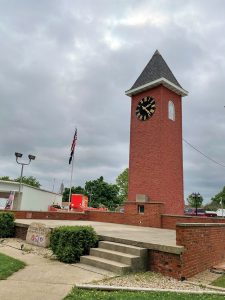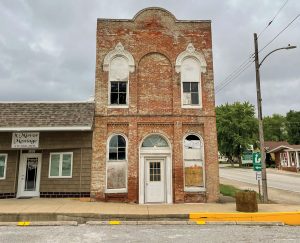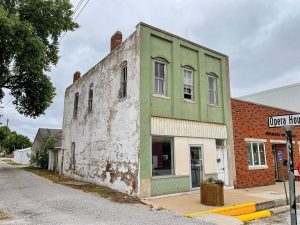 A clock tower stands in downtown Greenfield, dutifully keeping time. But time has not been a friend to many of the buildings surrounding it. As roofs and foundations crumble in the empty storefronts around the square, a group of young, driven people works to revitalize the community they call home.
A clock tower stands in downtown Greenfield, dutifully keeping time. But time has not been a friend to many of the buildings surrounding it. As roofs and foundations crumble in the empty storefronts around the square, a group of young, driven people works to revitalize the community they call home.
Aptly named, the city of Greenfield was first settled because of its fertile land. From its founding in the 1830s to this day, it continues to be a farming community. While its population has remained consistent throughout the years, at more than 1,000 residents according to the U.S. Census Bureau, its business district has dwindled. On the town square, fewer than half of the 15 buildings are occupied.
The Greenfield Revitalization Project (GRP) aims to change that.
“We’re all age 37 and younger,” Lauren Sprung says, a co-founder and president of GRP. “There’s a trend of people moving back to small towns. They like the sense of community that comes with rural America. I think it’s great having more people move back, and now we are trying to give them a reason to stay.”
Lauren and her sister Hannah Bauer grew up on a grain and livestock farm in Greenfield. Both moved away for college and found work – a business manager and an implementation project manager, respectively. When COVID-19 turned the world upside-down in 2020, both women moved back to their hometown when presented with the opportunity to work remotely.
“Moving back, I wanted more,” Lauren says. “I started asking the questions, ‘How did [Greenfield] get this way?’ ‘What can we do to help?’”
She talked to friends and family who gave similar responses – many had already asked those same questions, but no one knew where to start. “I didn’t either,” Lauren admits. “I’ve learned in my career to be resourceful. You don’t have to know everything. You just need the right people.”
The sisters approached Greenfield’s city council, and they were given its blessing to pursue the revitalization of the town’s square. From there, they started a Facebook group to “rally the troops.” The private Greenfield Revitalization Project group has grown to more than 550 members, consisting of current and former residents of the community.

Austin Brannum, who works from home as a dispatch manager, discovered the Facebook group. “That’s how I came to the original meeting,” he says. He learned more about the group and everything it hoped to accomplish. “They had so many great ideas, but everyone only has so much time to volunteer.”
He decided to join because he wanted to help in any way. “I thought, the more people who become part of this to take items off their list, the more helpful it would be.” He now manages public relations for GRP.
Not originally from the area, Austin moved to Greenfield to be near his grandmother, who lives outside of Carrollton. “Here’s the thing, everybody in Carrollton goes to the square to do things, and it was sad for me that it isn’t like that here,” he says. “That’s what I want it to become someday.”
Sandwiched between two small town communities with successful downtown districts, with Carlinville on the east and Carrollton to the west, Greenfield’s square does not have much to offer in comparison.
“These towns around us are extremely established and are getting more established,” Hannah says, who is a co-founder and secretary-treasurer for GRP. “They are motivating for us.”
Members of the city of Carrollton started a similar endeavor several years ago called the Carrollton Square Initiative. “Their square is booming at this point,” Hannah says. “They have so many small businesses and are doing beautiful things with their square.”

They reached out to the Carrollton group for advice, and the lawyer there helped them make GRP a non-profit 501(c)(3) organization, which became official in January 2021. The lawyer, Nick Graham, has helped the group pro bono because “he believes in what we are trying to do,” Lauren says. “Without Carrollton, we probably wouldn’t have gotten this off the ground, or at least not as quickly.”
GRP recently scored its first major win by helping to kickstart a recycling program. “It’s a small victory, but those add up over time,” Austin says.
In addition, the group encouraged local churches to establish daycare in the area since they are already equipped with facilities needed. The First Baptist Church of Greenfield will soon open its Little Disciples Daycare.
“I consider daycare as important as roads in terms of infrastructure,” Lauren explains. “If adults don’t have anywhere to take their kids, they can’t work.”
At first, GRP acted more like a real estate agency to help sell the vacant spaces to potential business owners. After facilitating several showings, they heard much of the same feedback. The buildings were too far gone, and renovation wouldn’t be affordable. However, the potential business owners did say they would be interested in leasing.
“That’s when a light bulb went off,” Lauren says. “GRP needs to buy and restore the buildings with grants and donations.”
“There are quite a few people we’ve already talked to,” Hannah says. “One couple who lives outside of town wants to own and operate a restaurant. There are a lot of cool ideas. If we can bring these buildings to people, they’re going to bring businesses to town.”
Once the buildings are restored, GRP plans to lease them and will reinvest that money into other projects on the square and in the community. The group hopes to purchase as many of the empty buildings as possible, despite their condition.

“Let’s either demolish it and do something else with that space or restore it,” Lauren says. In fact, she personally owns one of the buildings on the square, which has been determined past restoration. “It just needs torn down,” she says, adding that she’d rather buy it and tear it down than let it sit empty with no hope of restoration.
“We’ve been told by many architects to just tear them down and build them back up,” Lauren says. “But we are trying to restore and maintain that historical charm these buildings bring to the square.”
GRP recently purchased one of the brick buildings with the help of local donations. Built in 1872, it was first a bank, followed by a harness shop. While it was home to many businesses in its 150 years, it has remained empty for at least a decade.
“The professionals said we probably had two years to save the building before it would need torn down,” Lauren says. “Now we’re hustling for money to do a full roof replacement and board up the windows to stop the deterioration, which will give us more time to do the full restoration.”
Once the renovation is complete, the upstairs level will be leased to a local business to host an Airbnb, and the lower level will become a coffee shop complete with ice cream, a deli, a bakery and a lounge area.
“Now we have laid groundwork to move forward with the others. The only thing is funding,” Lauren says. Needless to say, a complete renovation of an old building is expensive.
“When restoring something like that, I’ve been told to plan on a half million, and if you don’t have grant money, that’s almost impossible,” Lauren says. “At that point, you’re not even talking about capital to start a business, you’re talking about capital to just make the structure livable.”
GRP constantly applies for grants (private, state and federally funded) and accepts donations to help with the project. The group has been lucky enough to receive several grants and is optimistic about pending ones that will give them the ability to do a full roof replacement, board up windows, and get masonry work done to stop the deterioration and begin a full interior demo.
Applying for grants is tedious work, especially for state-funded ones, according to Jenny Hoots, who moved to Greenfield in February 2020 and is the vice president of GRP. She knows a thing or two about grants because she works for the Illinois Department of Commerce and Economic Opportunity in the office of grants management.
“There are a lot of hoops to jump through, and that’s just in the initial process,” Jenny explains. “If you do get approved, you continue to jump through hoops throughout the process and must report on what happens after the project is complete to ensure the money was allotted correctly. There are checks and balances all the way.”
“Luckily, Jenny joined our team and helped us understand the grants out there,” Lauren says. “There is free money to help with this. You’ve got to know where to look and how to put a good narrative together.”

In addition to grants, GRP hosts fundraising events, organized by its fundraising chair Lisa Goode. On June 11, the group hosted its first Family Fun Day at the lake, which included kickball, bags, fishing and volleyball tournaments. This fall, the group will hold its second annual antique car show around the square on Oct. 8. Thirty-five cars showed up to the event last fall, raising $1,000 for the project.
“We’re expecting an even bigger turnout this year,” Lauren says, adding that they hope to bring more food trucks, games and a band to make it a bigger event.
From the start, GRP has hosted monthly meetings at the local bar and grill on the first Tuesday each month, right before the city council meets. While the turnout is small, most interaction is in the Facebook group, where the meeting minutes are posted, so people can stay up to date on progress.
“We have people who anticipate the meeting minutes,” Hannah explains. “We have people engaged on our social media. A lot of people ask questions or reach out to us privately.”
So far, feedback from the community has been mixed.
“We have members in the community who are extremely supportive,” Hannah says. “They watch our every move, ask questions and communicate with us. But there are people who have their doubts, and that’s fine. Everyone is entitled to their own opinion. But that’s our motivation. We can’t wait to share the new buildings, share the businesses and bring opportunities to town. At that point, they’ll absolutely enjoy the work that we’ve been doing.”
They say it has taken time to gain confidence from the community. After a year of hard work, donations really started to come in. “They’ve seen that we are resilient,” Lauren says. “I think people are taking us more seriously and understand that we are in it for the long haul.”
“There has been a history of people buying or inheriting buildings and leaving them sit, or they have big plans but don’t follow through with any action,” Jenny adds. “A lot of people think this might be the same situation. It is our job to constantly make progress, even if it is a small change, to make sure people know things are happening.”
“Now there’s an actual building to back up what we’re doing,” says Hunter Masters, who works as a grain originator and joined GRP to help with public relations for special projects. “People can see what their money is going toward instead of just handing us a check and hoping.”
Hunter confirms that many young adults are moving back to the community. At 23, he returned after college, and says many of his friends are buying houses in the area and starting families. “From my generation, I’ve seen nothing but positive feedback,” he says. “People like me are excited for the future, knowing what this group is doing.”
“Our ultimate dream is to see this town fully populated,” Hannah says. “We want to have this square booming with businesses and have all the basic amenities here in town. We want it to have that old time feel … and just live a good solid, simple life.”









